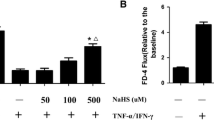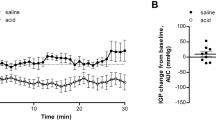Abstract
Objectives
To investigate the regulatory effect of histamine on the barrier function of intestinal mucosal.
Methods
The monolayer Caco-2 cell system in vitro and the model of hemorrhage infection in rats in vivo were established as experimental models. The amount of bacterial translocation was taken as an index of the effect of histamine and its receptor antagon, cimetidine on the intestinal mucosal barrier function.
Results
(1) The in vitro experiment showed that after treatment with histamine, the CFU of Escherichia coli 075 invading into Caco-2 cells were much lower than that in the control group (P < 0.05). (2) The animal experiment showed that in the histamine group (hemorrhage infection rats treated with histamine), the average numbers of bacteria in the liver and lymph nodes were much lower than that in control group (P < 0.05). The mean bacterial number in the cimetidine group (hemorrhage infection rats treated both with histamine and cimetidine) was more than that in the histamine group, but without statistical signification (P > 0.05). But the rate of translocation to the liver between histamine group (37.5%) and cimetidine group (100%) was statistically different (P < 0.05)
Conclusion
Small concentration of histamine can inhibit bacteria from entering epithelial cells and inhibit intestinal bacterial translocation.

Similar content being viewed by others
References
Vincent JL, Bihari DJ, Suter PM, Bruining HA, White J, Nicolas-Chanoin MH, Wolff M, Spencer RC, Hemmer M. The prevalence of nosocomial infection in intensive care units in Europe. Results of the European Prevalence of Infection in Intensive Care (EPIC) Study. EPIC International Advisory Committee. JAMA 1995;274:639–644.
Hospital-acquired pneumonia in adults: diagnosis, assessment of severity, initial antimicrobial therapy, and preventive strategies. A consensus statement, American Thoracic Society, November 1995. Am J Respir Crit Care Med 1996;153:1711–1725.
Fagon JY, Chastre J, Hance AJ, Montravers P, Novara A, Gibert C. Nosocomial pneumonia in ventilated patients: a cohort study evaluating attributable mortality and hospital stay. Am J Med 1993;94:281–288.
Leu HS, Kaiser DL, Mori M, Woolson RF, Wenzel RP. Hospital-acquired pneumonia. Attributable mortality and morbidity. Am J Epidemiol 1989;129:1258–1267.
Craven DE, Kunches LM, Lichtenberg DA, Kollisch NR, Barry MA, Heeren TC, McCabe WR. Nosocomial infection and fatality in medical and surgical intensive care unit patients. Arch Intern Med 1988;148:1161–1168.
Wenzel RP. The mortality of hospital-acquired bloodstream infections: need for a new vital statistic? Int J Epidemiol 1988;17:225–227.
Driks MR, Craven DE, Celli BR, Manning M, Burke RA, Garvin GM, Kunches LM, Farber HW, Wedel SA, McCabe WR. Nosocomial pneumonia in intubated patients given sucralfate as compared with antacids or histamine type 2 blockers. The role of gastric colonization. N Engl J Med 1987;317:1376–1382.
du Moulin GC, Paterson DG, Hedley-Whyte J, Lisbon A. Aspiration of gastric bacteria in antacid-treated patients: a frequent cause of postoperative colonisation of the airway. Lancet 1982;1:242–245.
Daschner F, Kappstein I, Engels I, Reuschenbach K, Pfisterer J, Krieg N, Vogel W. Stress ulcer prophylaxis and ventilation pneumonia: prevention by antibacterial cytoprotective agents? Infect Control Hosp Epidemiol 1988;9:59–65.
Tryba M. Prophylaxis of stress ulcer bleeding. A meta-analysis. J Clin Gastroenterol 1991;13 Suppl 2:S44–55.
Laggner AN, Lenz K, Gentey LO. The influence of pH elevation on the incidence of nosocomial pneumonia. J Intensive Care Med 1990;5:S17–S21.
Garvey BM, McCambley JA, Tuxen DV. Effects of gastric alkalization on bacterial colonization in critically ill patients. Crit Care Med 1989;17:211–216.
Tran DD, Cuesta MA, van Leeuwen PA, Nauta JJ, Wesdorp RI. Risk factors for multiple organ system failure and death in critically injured patients. Surgery 1993;114:21–30.
Avanoglu A, Herek O, Ulman I, Ergun O, Tunger A, Alkanat M, Erdener A. Effects of H2 receptor blocking agents on bacterial translocation in burn injury. Eur J Pediatr Surg 1997;7:278–281.
O’Keefe GE, Gentilello LM, Maier RV. Incidence of infectious complications associated with the use of histamine2-receptor antagonists in critically ill trauma patients. Ann Surg 1998;227:120–125.
Basaran UN, Celayir S, Eray N, Ozturk R, Senyuz OF. The effect of an H2-receptor antagonist on small-bowel colonization and bacterial translocation in newborn rats. Pediatr Surg Int 1998;13:118–120.
Kappstein I, Schulgen G, Friedrich T, Hellinger P, Benzing A, Geiger K, Daschner FD. Incidence of pneumonia in mechanically ventilated patients treated with sucralfate or cimetidine as prophylaxis for stress bleeding: bacterial colonization of the stomach. Am J Med 1991;91:125S–131S.
Ben-Menachem T, Fogel R, Patel RV, Touchette M, Zarowitz BJ, Hadzijahic N, Divine G, Verter J, Bresalier RS. Prophylaxis for stress-related gastric hemorrhage in the medical intensive care unit. A randomized, controlled, single-blind study. Ann Intern Med 1994;121:568–575.
Eddleston JM, Vohra A, Scott P, Tooth JA, Pearson RC, McCloy RF, Morton AK, Doran BH. A comparison of the frequency of stress ulceration and secondary pneumonia in sucralfate- or ranitidine-treated intensive care unit patients. Crit Care Med 1991;19:1491–1496.
Reusser P, Gyr K, Scheidegger D, Buchmann B, Buser M, Zimmerli W. Prospective endoscopic study of stress erosions and ulcers in critically ill neurosurgical patients: current incidence and effect of acid-reducing prophylaxis. Crit Care Med 1990;18:270–274.
Laggner AN, Lenz K, Base W, Druml W, Schneeweiss B, Grimm G. Prevention of upper gastrointestinal bleeding in long-term ventilated patients. Sucralfate versus ranitidine. Am J Med 1989;86:81–84.
Simms HH, DeMaria E, McDonald L, Peterson D, Robinson A, Burchard KW. Role of gastric colonization in the development of pneumonia in critically ill trauma patients: results of a prospective randomized trial. J Trauma 1991;31:531–536; discussion 536–537.
Ryan P, Dawson J, Teres D, Celoria G, Navab F. Nosocomial pneumonia during stress ulcer prophylaxis with cimetidine and sucralfate. Arch Surg 1993;128:1353–1357.
Martin LF, Booth FV, Karlstadt RG, Silverstein JH, Jacobs DM, Hampsey J, Bowman SC, D’Ambrosio CA, Rockhold FW. Continuous intravenous cimetidine decreases stress-related upper gastrointestinal hemorrhage without promoting pneumonia. Crit Care Med 1993;21:19–30.
Fiddian-Green RG, Baker S. Nosocomial pneumonia in the critically ill: product of aspiration or translocation? Crit Care Med 1991;19:763–769.
Hanisch EW, Encke A, Naujoks F, Windolf J. A randomized, double-blind trial for stress ulcer prophylaxis shows no evidence of increased pneumonia. Am J Surg 1998;176:453–457.
Cruz N, Qi L, Alvarez X, Berg RD, Deitch EA. The Caco-2 cell monolayer system as an in vitro model for studying bacterial–enterocyte interactions and bacterial translocation. J Burn Care Rehabil 1994;15:207–212.
Nieuwenhuijzen GA, Goris RJ. The gut: the “motor” of multiple organ dysfunction syndrome? Curr Opin Clin Nutr Metab Care 1999;2:399–404.
Yao Y, Yu Y, Wu Y, Shi Z, Sheng Z. The role of gut as a cytokine-generating organ in remote organ dysfunction after intestinal ischemia and reperfusion. Chin Med J (Engl) 1998;111:514–518.
Ammori BJ. Role of the gut in the course of severe acute pancreatitis. Pancreas 2003;26:122–129.
Stern LE, Erwin CR, O’Brien DP, Huang F, Warner BW. Epidermal growth factor is critical for intestinal adaptation following small bowel resection. Microsc Res Tech 2000;51:138–148.
Chen W, Fu XB, Ge SL, Sun TZ, Li WJ, Sheng ZY. Acid fibroblast growth factor reduces rat intestinal mucosal damage caused by ischemia-reperfusion insult. World J Gastroenterol 2005;11:6477–6482.
McAlindon ME, Mahida YR. Pro-inflammatory cytokines in inflammatory bowel disease. Aliment Pharmacol Ther 1996;10 Suppl 2:72–74.
Wong SC, Macrae VE, McGrogan P, Ahmed SF. The role of pro-inflammatory cytokines in inflammatory bowel disease growth retardation. J Pediatr Gastroenterol Nutr 2006;43:144–155.
Chen K, Okuma T, Okamura K, Torigoe Y, Miyauchi Y. Glutamine-supplemented parenteral nutrition improves gut mucosa integrity and function in endotoxemic rats. JPEN J Parenter Enteral Nutr 1994;18:167–171.
Rao XP, Zhu LQ, Lian HH. Protective effects of glutamine on the intestinal mucosal barrier in young rabbits under hemorrhagic shock. Zhongguo Dang Dai Er Ke Za Zhi 2006;8:66–70.
Spaeth G, Specian RD, Berg RD, Deitch EA. Bulk prevents bacterial translocation induced by the oral administration of total parenteral nutrition solution. JPEN J Parenter Enteral Nutr 1990;14:442–447.
Chen D, Aihara T, Zhao CM, Hakanson R, Okabe S. Differentiation of the gastric mucosa. I. Role of histamine in control of function and integrity of oxyntic mucosa: understanding gastric physiology through disruption of targeted genes. Am J Physiol Gastrointest Liver Physiol 2006;291:G539–544.
Schubert ML. Gastric secretion. Curr Opin Gastroenterol 2005;21:636–643.
Utgaard JO, Jahnsen FL, Bakka A, Brandtzaeg P, Haraldsen G. Rapid secretion of prestored interleukin 8 from Weibel–Palade bodies of microvascular endothelial cells. J Exp Med 1998;188:1751–1756.
Miyata R, Iwabuchi K, Watanabe S, Sato N, Nagaoka I. Short exposure of intestinal epithelial cells to TNF-alpha and histamine induces Mac-1-mediated neutrophil adhesion independent of protein synthesis. J Leukoc Biol 1999;66:437–446.
Meslin JC, Wal JM, Rochet V. Histamine and mast cell distribution in the intestinal wall of the germ free and conventional rats. Influence of the mode of sterilization of the diet. Agents Actions 1990;29:131–137.
Huneau JF, Tome D, Wal JM. Histamine content, diamine oxydase and histidine decarboxylase activities along the intestinal tract of the rat. Agents Actions 1989;28:231–234.
Competing Interests
The authors declare that they have no competing interests.
Author information
Authors and Affiliations
Corresponding author
Rights and permissions
About this article
Cite this article
Duan, L., Chen, X. & Alexander, J.W. Regulatory Effect of Histamine on the Barrier Function of Intestinal Mucosal. J Gastrointest Surg 14, 1180–1185 (2010). https://doi.org/10.1007/s11605-010-1208-9
Received:
Accepted:
Published:
Issue Date:
DOI: https://doi.org/10.1007/s11605-010-1208-9




